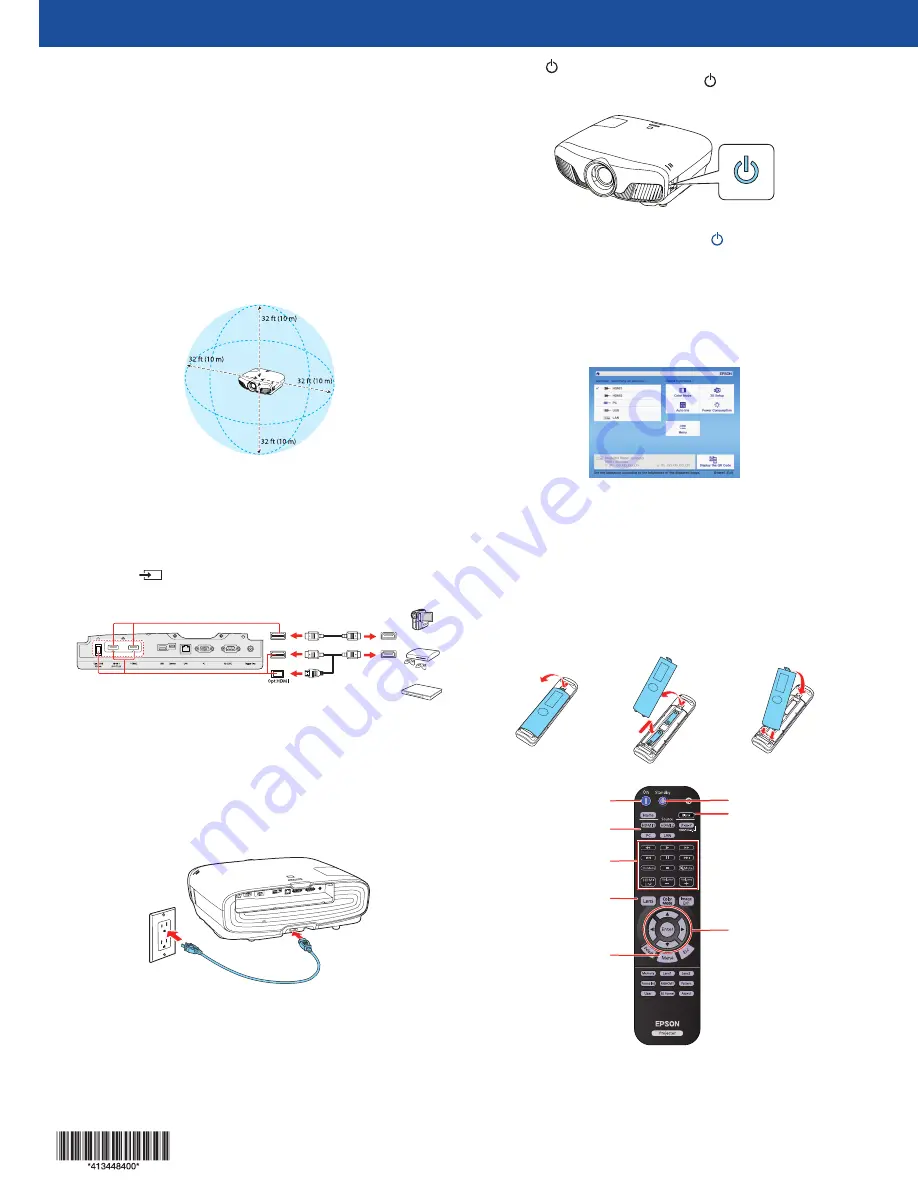
Quick Setup
Before using the projector, make sure you read the safety instructions in the
online User’s Guide.
Choose a location
Keep the projector level and place it at a height so its lens is even with the top
or bottom of the screen and is centered horizontally. If this isn’t possible, use
the lens shift feature or the keystone correction button on the projector to
reposition the image (see “Adjust the image”).
In order to view 3D images correctly, RF 3D glasses must be worn within 32 feet
(10 m) of the projector. Use the image below to determine the viewing distance
for 3D projection (the shading represents the 3D viewing area):
See the online User’s Guide for more information on where to place your
projector.
Connect the projector
Connect multiple video devices and use the Source buttons on the remote
control or the
button on the projector to switch between them. For
additional connection types, see the online User’s Guide.
HDMI cable
Optical HDMI
Note:
When connecting a source that requires HDCP 2.2, you must use the
HDMI1 port.
Turn on your equipment
1
Turn on your video source.
2
Plug in the projector.
3
Press the
power button on the projector or the
On
button on the
remote control. The shutter opens and the
power light flashes blue,
then stays on.
Note:
To shut down the projector, press the
power button on the
projector or the
Standby
button on the remote control, then press the
button again to confirm, if necessary. Wait for cooldown to complete
before unplugging the projector.
4
Use the arrow buttons on the remote control to highlight any of the
options on the Home screen that appears, then press
Enter
to select it.
You can display a QR code, switch between projection sources, and quickly
access various adjustment options from this screen.
5
The default language of the menu system is English. To select another
language, press the
Menu
button on the projector or remote control.
Select
Extended
and press
Enter
. Select
Language
and press
Enter
.
Select your language and press
Enter
. Press the
Menu
button to exit
the menu system.
Using the remote control
Install the batteries as shown (two AA batteries).
Choose which source to
display
Turn projector on
Access projector menus
Adjust zoom, focus,
and lens shift
Turn off projector
display
Navigate projector
menus
Turn projector off
Control connected
sources with HDMI
Link
For more information on using the remote control, see the online User’s Guide.
Adjust the image
1
Press the
Pattern
button on the remote control to display a test pattern.
2
To raise the image or correct a tilted image, adjust the front feet as
shown below.
3
Press the
Lens
button on the remote control and use the and buttons
to focus the image.
4
Press the
Lens
button on the remote control again and use the and
buttons to reduce or enlarge the image.
5
Press the
Lens
button on the remote control again and use the , ,
, and buttons to reposition the image.
6
If your image looks like
or
, you can use the buttons on the
projector to correct this.
Note:
Using the keystone adjustment can affect the size and effective
resolution of your image. If possible, change the position of your
projector to eliminate the keystone effect and use the lens shift option
to position the image as necessary.
7
Press
Esc
to exit.
Viewing 3D images
To view 3D content, you must first connect a 3D-compatible video device to
one of the HDMI ports on your projector. You also need a pair of Epson
®
(part
number V12H548006) or Epson-compatible RF 3D active shutter glasses.
1
Turn on and begin playback on the 3D-compatible video device.
Note:
Make sure you set the video device to play content in 3D mode.
2
Slide the power switch on your 3D glasses to the
On
position.
Note:
If the glasses don’t automatically display 3D content, you may need
to pair them with the projector. Move the glasses within 10 feet (3 m) of the
projector, then press and hold the
Pairing
button on the 3D glasses for at
least 3 seconds. The status light on the glasses will alternately flash green and
red, then remain green for 10 seconds if pairing is successful.
You can also automatically convert 2D HDMI content to 3D. To enable the
2D-to-3D Conversion option, press the
Menu
button on the projector or
remote control. Select
Signal
and press
Enter
, then select
3D Setup
and
press
Enter
. Select
2D-to-3D Conversion
and press
Enter
. Select the
Weak
,
Medium
, or
Strong
setting, then press
Enter
.
See the online User’s Guide for more information on adjusting 3D images.
Home Cinema 4000




